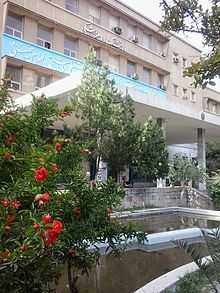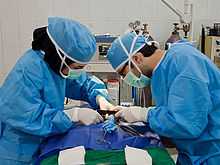Faculty of Veterinary Medicine, University of Tehran
Coordinates: 35°42′06″N 51°23′02″E / 35.7017381°N 51.3840259°E
| Faculty of Veterinary Medicine | |
|---|---|
 | |
| Motto | Cum Humanitate Scientia |
| Established | 1835 |
| Type | Veterianry Medicine College and Pet Hospital |
| Principal | Professor Dr.Rostami |
| Location | Tehran, iran |
| Affiliations | University of Tehran |
| Website | www.vetmed.ut.ac.ir |
In 1937, the Faculty of Veterinary Medicine Sciences was renamed the Faculty of Veterinary Medicine and by 1945 it joined the University of Tehran. Currently, the main campus of the faculty is located at the heart of the Tehran metropolis and was constructed in 1950s.
History
he faculty is doubtlessly the backbone of veterinary research and education in Iran. The academic staff consists of more than 100 full-time faculty members and many adjunct professors also support the faculty mainly in postgraduate studies. Seven professors from the faculty have been honored in the Everlasting People of Iran, one of the most prestigious national scientific and cultural awards. Consisting of twelve academic departments, the faculty has a leading role in postgraduate training of veterinary and animal sciences in Iran. Moreover, two Veterinary Research and Teaching Hospitals for small and large animal medicine and also two separate specialized referral clinics for avian species and aquatic animals are pioneering state-of-the-art veterinary centers in the region. The professional veterinary clinicians (as the faculty staff) not only provide nation-wide veterinary services, but are also consulted by neighboring countries.
Departments
Department of Aquatic Animals Health and Diseases Department of Food Hygiene and Quality Control Department of Microbiology and Immunology Department of Pharmacology Department of Pathology Department of Avian Diseases Department of Animal and Poultry Health and Nutrition Department of Veterinary Surgery and Radiology Department of Veterinary Internal Diseases Department of Veterinary Theriogenology and Obstetrics Department of Basic Sciences
Educations
Doctor of Veterinary Medicine (DVM) Doctor of Veterinary Medicine (DVM) is the only undergraduate program offered in the Faculty of Veterinary Medicine. Training veterinary general practitioners and public health consultants is the main goal of this program. Native applicants must take the state-level university entrance exam held by the Ministry of Science, Research and Technology (Sanjesh Organization). Foreign applicants are requested to contact the International Students Office at the UT. They should hold a high school certificate or diploma with a minimum GPA of 14 out of 20 (2.8 out of 4.0). It takes 6 years (12 semesters) to earn a DVM degree and an undergraduate dissertation project is required for graduation.
Residency: Doctor of Veterinary Sciences (DVSc) DVSc is a combined course-based and clinical training program in different veterinary pathobiologic and clinical disciplines. Applicants must hold a DVM degree or its equivalent with a minimum GPA of 15 out of 20 (3.0 out of 4.0). In addition to academic courses, diagnostic tasks and an applied dissertation research; all DVSc students should pass a board exam in their relevant major to fulfill the graduation requirements.
PhD Many PhD programs are offered by different departments for foreign and native students in order to pursue research beyond the master’s degree. Currently, advanced graduate work is provided in parasitology, aquatic animal, feed hygiene and quality control, epidemiology, theriogenology, clinical pathology, biotechnology, anatomy, histology, biochemistry, toxicology, pathology, virology, bacteriology, immunology, mycology, physiology and pharmacology. The applicants must have a DVM or MSc degree from an accredited institution with a minimum GPA of 15 out of 20 (3.0 out of 4.0). Initially the accepted candidates undertake predefined units of theoretical courses, and then a supervised research thesis relevant to the chosen area of study is written and submitted for examination by a minimum of two external examiners.
Hospital and Clinic

Tehran Small Animal Research and Teaching Hospital
Tehran Small Animal Research and Teaching Hospital 1. Tehran Small Animal Research and Teaching Hospital: Located at the heart of the city, Tehran SARTH is the busiest small animal referral center in the country. Tehran SARTH is fully equipped and enjoys state of the art diagnostic and interventional instruments in five sections: 2. Small animal internal medicine: In addition to performing routine diagnostic procedures on referred animals, the specialized cardiologic, neurologic, edoscopic, and ophthalmoscopic diagnostic equipment assist the faculty members and residents of the SARTH to provide the best diagnostic and therapeutic services for the animal owners. 3. Wild and exotic animal referral center: Almost all zoos in the country occasionally refer their animals to the SARTH, as they know the best services and high-tech medical procedures are available at this center. The faculty of veterinary medicine has many contracts with different animal collections, zoos and conservation programs, and also has a unique section specifically for the mentioned services. 4. Diagnostic imaging: SARTH is the exclusive center for digital radiology, fluoroscopy, ultrasonography, echocardiography, and computed tomography for small animals in the country. Numerous small animal, avian and exotic animal cases are referred to this center on a daily basis, making the diagnostic imaging section of the SARTH the best educational center not only in the country, but also in the region. 5. Surgery: Various kinds of orthopedic and soft tissue operations are performed by faculty members and postgraduate surgery residents. Microsurgery, endosurgery, spinal surgery and ophthalmosurgery are some of the specialized procedures carried out in this section. Stem cells tissue engineering, low level laser therapy, trans-species tissue grafting, and innovative endosurgical approach are some of the running projects in this section. 6. Diagnostic laboratory: Performing diagnostic clinical biochemistry tests, hematologic investigation, cytologic examination of clinical specimens, and microbiologic procedures are the main tasks of the diagnostic laboratory of SARTH, which is under the supervision of the faculty members of the department of pathology. 7. Pet bird Clinic: Having more than 2,500 cases each year makes the Avian Clinic of the UT, one of the busiest clinics in the region. In addition to the companion and exotic avian examination rooms, the clinic has a necropsy and a specialized diagnostic laboratory which perform most of the routine diagnostic tests on the referred birds. An operation room equipped with anesthesia machine, endoscopy and laparoscopy instruments are other facility in this clinic.
Mardabad Veterinary Research and Teaching Hospital (VRTH)
Mardabad VRTH was officially opened in 1998. Mardabad VRTH is located in Mahdasht Road in south of Karaj, about 35 km west of Tehran. In fact this hospital was operating in the city of Tehran under the name Vasfenar Veterinary Clinic since 1934. All of the clinical disciplines and veterinary sections required for an ideal VRTH are located in a 1.5 hectares (3.7 acres) building of the hospital, including: large animal internal medicine, necropsy and postmortem examination, small animal internal medicine, surgery, radiology, poultry diagnostic and research laboratories, diagnostic microbiology and clinical pathology laboratories.
External links
| ||||||||||||||||||||||